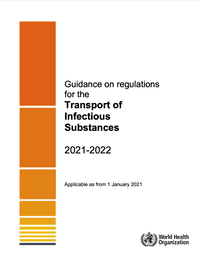Guidance on Regulations for the Transport of Infectious Substances
[Transport of Infectious Substances]
These guidelines facilitate compliance with applicable international regulations for the transport of infectious substances. The document provides information for classifying, identifying, packaging, marking, labelling, documenting and refrigerating infectious substances for transportation and ensuring their safe delivery. These guidelines are designed to assist in the development of country-level policies.
SUMMARY
The World Health Organization (WHO) Guidance on Regulations for the Transport of Infectious Substances is a bi-annual publication that facilitates compliance with applicable international regulations for the transport of infectious substances by all modes of transport. The guidance provides information for classifying, identifying, packaging, marking, labelling, documenting, and refrigerating infectious substances for transportation and ensuring their safe delivery. The guidance is relevant for all users along the transportation pipeline, including shippers, packaging suppliers, package carriers, and receivers. The guidance is especially relevant during public health emergencies when transportation of samples is needed to detect and respond to emerging outbreaks. The guidance was first published in 1997, and was most recently updated in 2021.
The European Union sponsors the continued updates of this guidance and it is reviewed by the International Air Transport Association (IATA). The IATA releases complimentary biological material shipping guidelines. The guidance also compliments the United Nations Recommendations on the Transport of Dangerous Goods, a biannual general international transportation guide. The UN regulations and the WHO guidelines are designed to assist in the creation of legally binding, country level policies.


..png)
